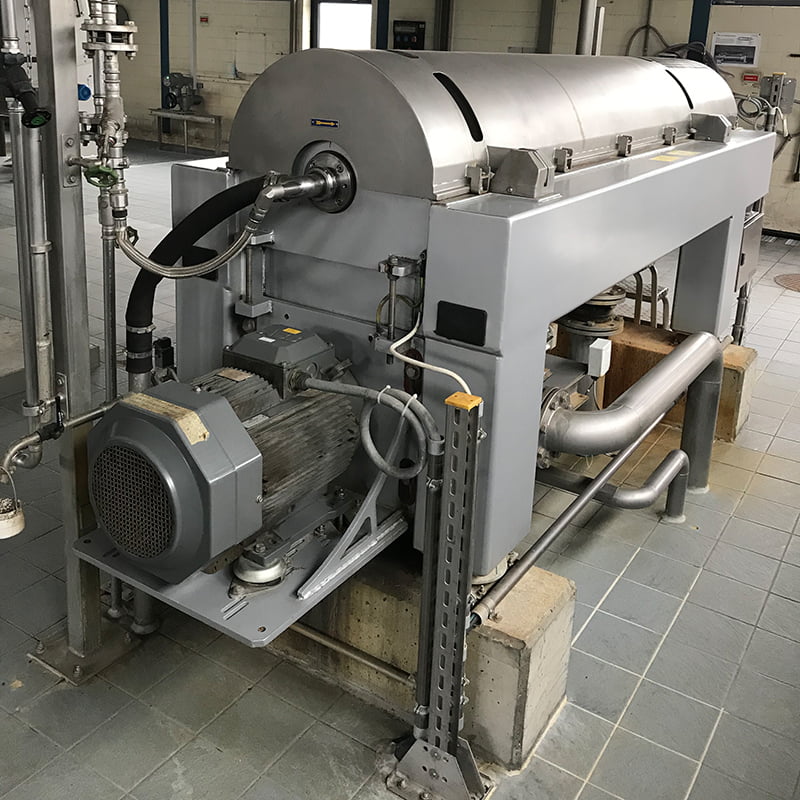This website uses cookies so that we can provide you with the best user experience possible. Cookie information is stored in your browser and performs functions such as recognising you when you return to our website and helping our team to understand which sections of the website you find most interesting and useful.
Case Study: RWI-8000
BACKGROUND
Wastewater treatment plants (WWTP) often experience a disruption in their operations due to the complex chemical reactions in the water cleaning process, further lowering the plant efficiency down to a critical level. A common cause is the rapid formation of rock-solid blue cement known as Struvite crystals that affects all metal surfaces during sludge dewatering.
THE CHALLENGE
At the ARA Wüeri in Regensdorf, Switzerland, after digestion, a centrifuge dewaters the produced sludge. Following CO2 degassing, the change in composition and physicochemical properties rapidly promotes the Struvite scale formation on all metallic surfaces during this process. Furthermore, Struvite scaling is rapid and furtive and creates an underestimated risk for failure and a severe impact on operational costs. Numerous testing with chemicals to prevent or impede the scaling inside and after Figure 1: Dewatering centrifuge the centrifuge could not eliminate the problem.
ARA Wüeri teamed up with a research group at the FHNW and Toray Membrane Europe AG (TMEU) to investigate the scaling and find a solution. TMEU introduced ROPUR RWI®-8000, an innovative water treatment chemical that specifically targets Struvite scaling. The team would test to determine the scale inhibitor’s effectiveness in maintaining the plant’s stable operations and minimize any hidden maintenance costs associated with equipment replacements.



DEWATERING PROCESS
Dissolved CO2 is aggressively released in the centrifuge area because:
- The tenside injected (dewetting agent) slightly reduces the CO2 solubility in water;
- The salt’s local micro-concentration (when TS particles separate from the fluid) triggers an unstable state in the dissolved CO2 gas;
- The centrifuge’s mechanical movements (pressure changes) optimize the gas exchange (with O2 and N2 saturating the fluid and kicking out the CO2) and CO2 release.

INNOVATION
The ROPUR RWI®-8000 was developed using state-of-the-art analytical techniques like laser-focused beam reflectance measurement, which in real-time can count the number of particles but also segment the particles according to their size. Actual sludge samples from the ARA Wüeri in Regensdorf were analyzed by adding a few doses (in ppm) of ROPUR RWI®-8000.
Upon dosing, the number of particles immediately reduced by 99.4%. The same method was applied to evaluate the optimal dosing rate for ROPUR RWI®-8000, which yielded dose rates ranging between 25 to 50 ppm.
The WWTP at ARA Wüeri uses ROPUR RWI®-8000 daily for its sludge dewatering process with great success, effectively inhibiting the Struvite scale from plugging or cementing inside the centrifuge and subsequent mother liquor pipes. Furthermore, the cleaning cost was reduced by a factor of four, as shown in Figures 5 and 6 below.


ROPUR RWI®-8000: THE IDEAL REFERENCE
Based on the latest generation of ion scavenging molecules effective at low dosing value, lab studies show that the ROPUR RWI®-8000 prevents Struvite formation for four hours after dosing, allowing the dewatering process to occur efficiently. Compared to similar chemicals on the market, ROPUR RWI®- 8000 expressed the most excellent efficiency at 25 and 50 ppm dosing rate, as shown in Figures 7 and 8.
Additionally, ROPUR RWI®-8000 performs well in wide pH deviations, minimizing issues regarding the remaining CO2 / Hydrogenocarbonate ion present in the mother liquor. Studies further revealed that ROPUR RWI®-8000 keeps all potential Struvite particles as small as 10 μm in size, which is a remarkable achievement. Users report significant savings in costs and simplification of the wastewater treatment process.


Download as PDF: RWI-8000 Case Study.pdf

